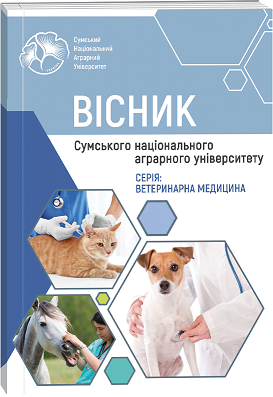PREVALENCE OF RABBIT EIMERIOSIS ASSOCIATIONS IN THE TERRITORIES OF SUMY REGION, VETERINARY-SANITARY AND PATHOMORPHOLOGY ASSESSMENT
Abstract
A clinical and epizootological examination was carried out, followed by a patho-anatomical autopsy of the corpses of rabbits under the age of one year from the homesteads of Romena, Okhtyr and Sumy communities, Sumy region, in order to determine the most common infectious pathologies of rabbits with their patho-anatomical reflection in the above-mentioned region, in order to study the most typical patho-anatomical signs that can be defined as "markers" in the future to establish a preliminary diagnosis. An autopsy was performed on fifty-one rabbit corpses with such pathologies as eimeriosis, myxomatosis, viral hemorrhagic disease of rabbits, as well as in their association. The dominant position of eimeriosis of rabbits among the rest of the specified pathologies was established during diagnostic examinations. Pathological-anatomical studies were carried out by means of a partial pathological-anatomical autopsy with an emphasis on the organs and their systems that are maximally involved in the pathogenesis of the disease. Through comprehensive research, it was established that eimeriosis, myxomatosis, and viral hemorrhagic disease of rabbits account for about ninety-nine percent of the cases of diagnosed deaths among rabbits of infectious and parasitic etiology. The following were subject to post-mortem veterinary and sanitary inspection: carcass, head and internal organs (lungs, heart, liver, intestines, spleen). Before the introduced patho-anatomical studies, a thorough analysis of the epizootic situation, clinical signs and anamnesis of the rabbits of the examined rabbit farms was carried out. Conversations with animal owners were necessarily held regarding their use of preventive and curative measures on their own rabbit farms. Particular attention was paid to the use of vaccines against myxomatosis and viral hemorrhagic disease of rabbits, its storage and use in accordance with the instructions. No less important was the analysis of chemoprophylactic and therapeutic agents for eimeriosis in rabbits and their rotation, under which conditions it was carried out (forced or planned). It was established that there were rare cases of death of rabbits from eimeriosis, despite the use of coccidiostats, as well as from myxomatosis and viral hemorrhagic disease of rabbits after the use of vaccines according to the instructions, which prompts us to think about the need to improve measures to combat the above-mentioned diseases. The pathoanatomical studies conducted by us showed the importance and high efficiency of this diagnosis for the rapid establishment of a preliminary diagnosis and, based on it, the implementation of forced measures to eliminate outbreaks of the specified diseases. Our research has established that the speed of decision-making in the fight against eimeriosis, myxomatosis and viral hemorrhagic disease of rabbits directly affects the amount of losses incurred from these diseases during an outbreak. It was diagnosed that when rabbits are caged in homesteads, eimeriosis is registered as a monoinvasion in 66.0% of rabbits, a mixed eimeriosis-myxomatous association – in 22.0%, an association of eimeriosis-viral hemorrhagic disease in 11.0%, as a monoinvasion manifests catarrhally – hemorrhagic menteritis, conjunctivitis and edema of the subcutaneous tissue are added in the eimeriosis-myxomatosis association, and the eimeriosis-viral hemorrhagic disease association – the dominant addition is hemorrhagic pneumonia and hemorrhagic tracheitis. After conducting a veterinary and sanitary inspection of slaughter products for Eimeria infestation, the affected organs: the small and large intestines and the liver were destroyed, and the carcass was boiled. Other slaughter products were without pathological changes. In order to further determine the effect on the incidence of rabbits against the background of mixed invasive and infectious diseases of rabbits, it is necessary to conduct a study on the correlation of the manifestation of these diseases with the use of preventive vaccinations and treatments against Eimeria.
References
2. Abrantes, J., van der Loo, W., Le Pendu, J., & Esteves, P.J. (2012). Rabbit haemorrhagic disease (RHD) and rabbit haemorrhagic disease virus (RHDV) a review. Vet. Res. Vol. 43, no. 1, pp. 12–22. doi:10.1186/1297-9716-43-12.
3. Ayan, A., Ahmed, I., & Khan, J. M. (2020). Hematological changes and comparative efficacy of allopathic and herbal drugs on coccidiosis in rabbits. Baltica, 33(2), 78–99.
4. Bezrukova, I. V., Mikhailenko, V. V., Lutsuk, S. N., & Vodianov, A. A. (2016). Morphological changes in rabbit eimeriosis. Bull. Agro. Ind. Complex Stavropol, 4(16): 99-103.
5. Bharathy, N., Ramesh, V., & Chandirasekaran, V. (2014). Buy performance of white giant and soviet chinchilla rabbits. Lambert Acad. Publ., p. 4-10.
6. Fagundes Gurgel, A., Sartori, A., & Pacheco de Araujo, F. (2005). Protozoan parasites in captive chinchillas (Chinchilla lanigera) raised in the State of Rio Grande do Sul, Brazil. Parasitol. Latinoam., 60, 186-188. doi:10.4067/S0717-77122005000200016
7. Franchuk, L.O. (2010). Poshyrennia ta formy perebihu zmishanoi eimerioznoi invazii u kroliv [Distribution and forms of mixed eimeria infection in rabbits]. Ahrarnyi visnyk Prychornomoria. Veterynarni nauky: zb. nauk. pr. [Agrarian Herald of the Black Sea region. Veterinary Sciences: collection of scientific articles]. Issue 56, pp. 148–153. [in Ukrainian].
8. Gavrylina, O. G., & Kolesnyk, A. A. (2016). Osoblyvosti laboratornoi diahnostyky eimeriozu kroliv [Features of laboratory diagnosis of rabbit eimeriosis]. Naukovo-tekhnichnyi biuleten Naukovo-doslidnoho tsentru biobezpeky ta ekolohichnoho kontroliu resursiv APK [Scientific and Technical Bulletin of the Research Center for Biosafety and Environmental Control of Agricultural Resources]. 4, 55–58. [in Ukrainian].
9. Hamid, P. H., Prastowo, S., & Kristianingrum, Y. P. (2019). Intestinal and hepatic coccidiosis among rabbits in Yogyakarta, Indonesia. Vet. World, 12(8), 1256–1260. doi:10.14202/vetworld.2019.1256-1260.
10. Ilic, T., Stepanovic, P., Nenadovic, K., & Dimitrijevic, S. (2018). Improving agricultural production of domestic rabbits in Serbia by follow-up study of their parasitic infections. Iranian Journal of Veterinary Research, Shiraz University, 19(4), 290-297. Retrieved from https://www.ncbi.nlm.nih.gov/pmc/articles/ PMC6361602
11. Jing, F., Yin, G., Liu, X., Suo, X., & Qin, Y. (2011). Large-scale survey of the prevalence of Eimeria infections in domestic rabbits in China. Parasitology Research, 110 (4), 1495–1500. doi: 10.1007/s00436-011-2653-4
12. Kornienko, L. E. (2003). Infektsiini ta invaziini khvoroby kroliv [Infectious and invasive diseases of rabbits]. Bila Tserkva, 288 p. [in Ukrainian].
13. Lutfullin, N. A., Lutfullin, M. H., & Shangaraev, R. I. (2016). The spread of rabbit eimeriosis in the private sector of the Republic of Tatarstan. Theory Pract. Combat. Parasit. Dis., 17, 228.
14. Maziz-Bettahar, S., Aissi, M., & Ainbaziz, H. (2018). Prevalence of coccidian infection in rabbit farms in North Algeria. Vet. World, 11(11), 1569–1573. doi:10.14202/ vetworld.2018. 1569-1573.
15. Maziz-Bettahar, S., Aissi, M., Ainbaziz, H., Bachene, M. S., Zenia, S., Ghisani, F. (2018). Prevalence of coccidian infection in rabbit farms in North Algeria. Veterinary World, 11(11), 1569–1573. doi: 10.14202/vetworld.2018.1569-1573.
16. Mkrtchyan, M. E., Sidorenko, K. V., & Klimova, E. U. (2019). Protozoalhelminthic associations of parasites in rabbits. Regul. Issues Vet. Med., 2, 40-42.
17. Okumu, P. O., Gathumbi, P. K., Karanja, D. N., Mande, J. D., Wanyoike, M. M., Gachuiri, C. K. (2014). Prevalence, pathology and risk factors for coccidiosis in domestic rabbits (Oryctolagus cuniculus) in selected regions in Kenya. Veterinary Quarterly, 34(4), 205–210. doi:10.1080/016521 76.2014.978044
18. Papchenko I. V. (2019). Patoloho-anatomichnyi roztyn trupiv silskohospodarskykh tvaryn z osnovamy sudovoi veterynarii: metodychni rekomendatsii dlia studentiv osvitnoho rivnia – mahistr ta slukhachiv Instytutu pisliadyplomnoho navchannia [Pathological and anatomical autopsy of farm animals with the basics of forensic veterinary medicine: methodical recommendations for students of educational level – master and students of the Institute of Postgraduate Studies]. Bila Tserkva, 47 p. [in Ukrainian].
19. Papchenko, I. V. (2021). Patoloho-anatomichni zminy za eimeriozu kroliv: Materialy II Mizhnarodnoi naukovoi konferentsii «Tradytsiini ta innovatsiini pidkhody do naukovykh doslidzhen» [Pathological and anatomical changes in eimeriosis of rabbits: proceedings of the II International Scientific Conference "Traditional and innovative approaches to scientific research"]. Odesa (September 10, 2021): "European Scientific Platform". pp. 89–92. [in Ukrainian].
20. Petrova Y (2019). Pasteurellosis and eimeriosis worldwide problems in the rabbit farms: A review. Trakia J. Sci., 1(17), 67–74. doi:10.15547/tjs.2019.01.011
21. Saidj, D., Aliouat, S., Arabi, F., Kirouani, S., Merzem, K., Merzoud, S. et. al. (2013). La cuniculture fermière en Algérie: une source de viande non négligeable pour les familles rurales. Livestock Research for Rural Development, 25(8). Retrieved from: http://www.lrrd.org/lrrd25/8/said25138.htm
22. Shevchik, R., Duda, Y., Gavrilina, O., & Samoyluk, H. (2021). Impact of Amaranthus hypochondriacus in nutrition for rabbits on meat quality: Journal of the Hellenic Veterinary Medical Society, № 72(1), 2713–2722. doi:10.12681/jhvms.26756.
23. Silva, S. M., Ferreira, C., Paupério, J., Silva, R. M., Alves, P. C., & Lemos, A. (2015). Coccidiosis in European rabbit (Oryctolagus cuniculus algirus) populations in the Iberian Peninsula. Acta Parasitologica, 60(2), 350–355. doi:10.1515/ap-2015-0049
24. Sivajothi, S., Reddy, B. S., & Rayulu, V. C. (2013). Intestinal coccidiosis infection in domestic rabbits. Inter. J. Biol. Res., 2(2), 48–50.
25. Szkucik, K., Pyz-Łukasik, R., Szczepaniak, K. O., & Paszkiewicz, W. (2013). Occurrence of gastrointestinal parasites in slaughter rabbits. Parasitology Research, 113 (1), 59–64. doi:10.1007/ s00436-013-3625-7
26. Velarde, R. (2017). Spillover Events of Infection of Brown Hares (Lepus europaeus) with Rabbit Haemorrhagic Disease Type 2 Virus (RHDV2) Caused Sporadic Cases of an European Brown Hare Syndrome-Like Disease in Italy and Spain. Transboundary and Emerging Diseases. 64(6), 1750–1761. doi:10.1111/tbed.12562.
27. Vlasenko, I. V. (2012). Krolivnytstvo – rezerv v zabezpecheni prodovolchoi bezpeky derzhavy [Rabbit breeding – a reserve in ensuring food security of the state]. Naukovyi visnyk Lvivskoho natsionalnoho universytetu veterynarnoi medytsyny ta biotekhnolohii imeni S.Z. Gzhytskoho [Scientific Bulletin of Lviv National University of Veterinary Medicine and Biotechnology named after S.Z. Grzyckyi], 2(4), 15–18. [in Ukrainian].
28. Yin, G., Goraya, M. U., Huang, J., Suo, X., Huang, Z., & Liu, X. (2016). Survey of coccidial infection of rabbits in Sichuan Province. SpringerPlus, 5(1). doi:10.1186/ s40064-016-2586-6

 ISSN
ISSN  ISSN
ISSN 



